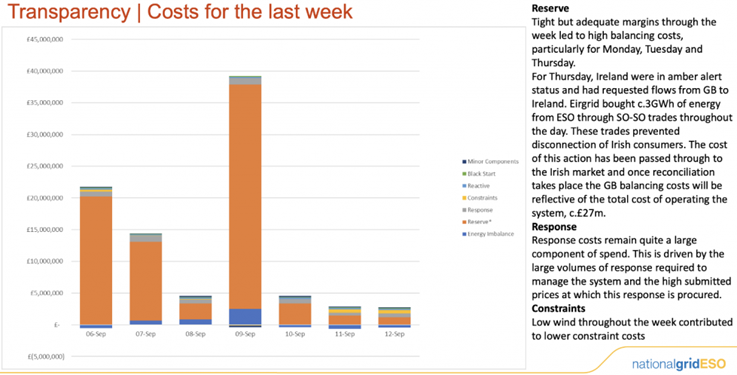Dr John Constable, GWPF Energy Editor
There is a clear danger that the growing reliance on interconnection to support windpower will expose the UK to political blackmail of the kind currently seen in the French government’s threats to disconnect electricity to the UK.
The Prime Minister will today give his conference keynote speech, the content of which has been widely anticipated in a series on interviews to the press. Mr Johnson is expected to repeat remarks already put on the record in the last few days that “we can get to complete clean energy production by 2035”:
The advantage of that is that it will mean that, for the first time, the UK is not dependent on hydrocarbons coming from overseas with all the vagaries in hydrocarbon prices and the risk that poses for people’s pockets and for the consumer. We will be reliant on our own clean power generation which will help us also to keep costs down.”
This Government is going to fix it for the long-term by making investments in renewable power that we can rely on in this country.”
The extraordinary naivety of these remarks confirms growing fears that Mr Johnson’s lack of understanding of the technical aspects of energy now presents a risk to national security and stability. He appears to have become the victim of unrealistic green lobbyists and of ideologically driven friends.
Mr Johnson’s careless remark that renewable power can be relied upon is a clear demonstration that he has only the weakest grasp of the extreme difficulties of guaranteeing security of supply on the electricity system in the presence of very large fleets of wind and solar generation.
Far from mitigating the UK’s current over-exposure to gas, which is the result of twenty years of renewables policies, more renewables will actually deepen the problem. As Alistair Philips-Davies of the major power company SSE very candidly admitted this week “there are clearly issues across the UK and Ireland systems at the moment”, adding that it may become necessary to build even additional gas-fired generation in order to secure the system.
Furthermore, Mr Johnson’s ambitions will require both extensive deployment of energy storage devices such as batteries, which are extremely expensive, and plagued by fires, and a still greater degree of interconnection with the European electricity network. This latter expansion is of particular concern at present.
The UK currently has about 7.8 GW of interconnectors operational or under construction, but the Energy White Paper has set a target of adding a further 10 GW of interconnection, bringing the total in operation to 18 GW, equivalent to nearly one third of peak national demand.
The capital costs of these interconnectors, which will amount to many billions of pounds, will be charged to consumers, and the ultimate beneficiaries of this large expenditure will be the shareholders in National Grid and their partners, who will enjoy stable economic rents for many decades.
Whether the consumer will benefit from economic energy trading is dubious, and there is a clear danger that this degree of interconnection will expose the United Kingdom to political blackmail of the kind currently seen in the French government’s use of scarcely-veiled threats to disconnect electricity to Jersey in order to gain leverage in a dispute over fishing rights.
The economic dangers of relying on interconnectors to support wind power and other renewables have recently been put into the spotlight by a little publicised crisis on the electricity network of the Republic of Ireland.
On the 9th of September the Irish grid operator, EirGrid, was faced with the practical certainty of blackouts in the Republic, largely due to the low wind conditions that have plagued Europe this year. The system was placed on Amber Alert and EirGrid made an emergency request to National Grid in the UK for supplies over the East West interconnector that runs between North Wales and County Dublin. This interconnector was originally expected to form a channel for the export of Irish wind power, but in practice often runs in the other direction.
As reported by National Grid in a statement on the Balancing Mechanism published just over a week on the 15th of September:
Eirgrid bought c. 3GWh of energy from ESO through SO-SO trades throughout the day. These energy trades prevented disconnection of Irish consumers.
These trades are known to have cost EirGrid some £12 million, or £4,000/MWh, about one hundred times the usual wholesale price, and a very large part of the total UK wide balancing cost for the day, as can be seen in National Grid’s own slide.

Figure 1: Balancing Mechanism Costs in the United Kingdom for the week 6th to 12th September 2021. Source: National Grid ESO.
The high price is explained by the fact that National Grid ESO in the UK redirected reserve fossil-fuelled generation that it was preparing for the UK. Reserve generation is in itself an expensive service, and the commitment to the Irish market potentially hazardous for the UK. A high price was inevitable.
This remarkable grid event is already attracting political comment in Northern Ireland, as evidence of dysfunctional energy policy. It also has important implications for the Northern Ireland Protocol which have yet to be fully explored in public debate. As Sammy Wilson MP for East Antrim has remarked:
"At the same time as the Republic is trying to strangle our economy with its insistence on the full implementation of the NI Protocol, the UK rushes to the aid of Ireland when it is in need."
As Mr Wilson makes clear, the UK did not exploit the Republic’s weakness on this occasion; indeed it went out of its way to help. But for Mr Johnson the lesson should be clear: relying on interconnectors from Europe to support UK windpower is at best economically dangerous, and at worst has the added potential to offer the European Union a powerful weapon.
KeyFacts Energy Industry Directory: Global Warming Policy Forum
 KEYFACT Energy
KEYFACT Energy